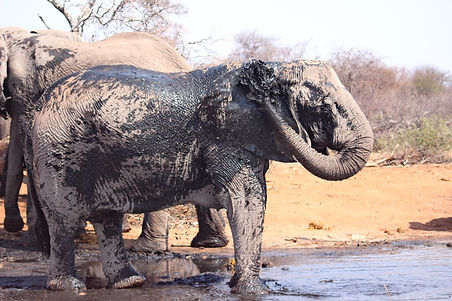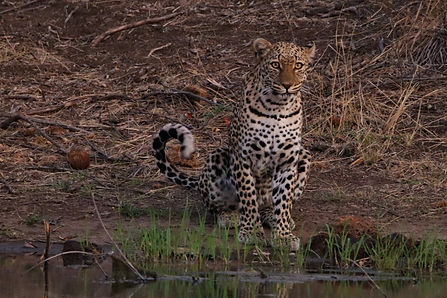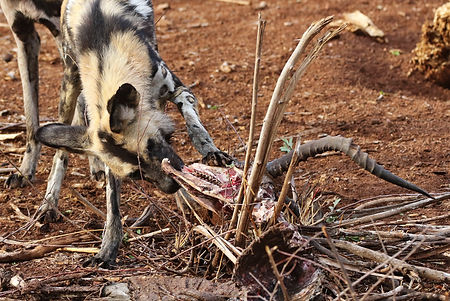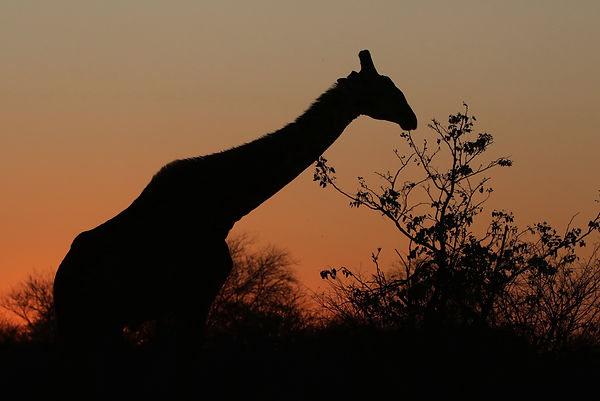Limpopo-Lipadi visit Sep/Oct 2024


Limpopo-Lipadi is a 21000 ha private game reserve in Botswana's Tuli Block, bordering the Limpopo River and South Africa. Since becoming shareholders in 2010 we have been visiting every year (apart from Covid years 2020 and 2021). In 2024 we had 2 stays, 1 week end of September and another 3 weeks in October, separated by a trip to northern Botswana. Several factors make Lipadi special: on the one hand the reserve has a number of rare and endangered species like White Rhinos, Wild Dogs and Brown Hyenas and on the other hand being a private reserve self driving, night driving, occasional off-road driving and also guided walks are possible. Protecting rare and vulnerable animals the reserve is fully fenced and professionally patrolled.
As usual we drove one of the reserve cruisers ourselves while on safari, but during the last 10 days - with family and friends joining - we were accompanied by field guide Moses.
Over the last almost 15 years we had many exciting wildlife encounters in the reserve (also see Limpopo-Lipadi page, found in the menue under Africa - Mammals) and we happily added some in 2024. Aim of this small report is giving some update of recent developments pointing out current possibilities of sightings.
general conditions
After a poor rainy season 23/24 and severe draught conditions all over Botswana it did not come as a surprise that the veld was very dry in late September 2024. However old grass (moribond with little nutritional value) was abundant. Waterholes including the reopened Mbusi were focal points for all wildlife.
Almost out of season the reserve received a big thunderstorm with heavy rains already in the night from sep20 and several more decent rains in October. The response was obvious when we left early November with abundant new grass and most trees having produced fresh leaves. Unfortunately looking at the severe draught conditions earlier in the year no areals were burnt as planned in 2024, which would have further triggered grass growth. Writing this at home in December I have learnt that Lipadi received exceptional downpours just before Christmas, so everything is indicating a very good rainy season 24/25 and conditions for browsers and grazers raising their young during the coming months should be good.
general game


In spite of the draught all animals were in reasonable and even good condition. In the absence of the last game count results here are some qualitative impressions:
Zebras were plentiful and they are doing very well. Distributed all over the reserve we have even seen a 40+ herd near Max.
Giraffes also were seen in good numbers, even though our lions have developed a taste for them. 3 mortalities during our stay had natural causes (like old age) without any indication of a disease breakout.
In spite of concerns regarding over predation (from hyenas, leopards and in particular wild dogs) we still found reasonable numbers of Impala including several 20+ herds, e.g. coming to drink at Mohorosi, Cabbage, Thelma and Pities. Regarding excellent conditions for this breeding season impala numbers can be hoped to rebounce.
Steenboks were found in good numbers, pairs of these small territorial browsers occupied every corner of the reserve.
Small numbers of Klippspringer as usual could be seen on the rocks around Jupiter spring, Dazzies also on Black Rock and Daily's Koppies.
However the picture looked less positive for other species:
Wildebeast are seemingly under pressure with rather few and only small groups present in the southern part of the reserve.
Eland as usual are shy and difficult to observe, we got just a few sightings at Two Cribs (at night), around Tholo and north of Mohorosi. Still our impression is that numbers have significantly dropped in recent years. It needs some research to better understand these developments, predation by lions (both species, wildebeast and eland, are regularly taken) may play some role, but regarding our currently low lion numbers (see below) and also apparently lower spotted hyena numbers (compared to previous years) other factors must play a role.
Kudus have obviously undergone a dramatic decline in recent years and did certainly not recover in 2024. They are currently present in low numbers in the reserve. Waterbuck are rare today, they may even face extinction in the reserve.
In contrast the corridor along the river (outside the fenced area) holds good numbers of both, Kudus and Waterbuck. They are easily seen even in close vicinity to the lodge. This may indeed indicate a problem with over predation in particular caused by our wild dogs, this will be further discussed below. Possibly Lipadi is not ideally suited for waterbuck, as these large antelopes are naturally drawn to the Limpopo river. Preferring the bush along the southern fence they easily fall prey to the wild dogs, which have learnt to use the fence to their advantage.

Impala herd drinking at Cabbage dam


Wildebeast and Giraffes at Mohorosi

Steenboks are independant of water, still this male decided to go for a drink.
Golden Wildebeast are a rare mutation, there are only three or four in Lipadi. This individual somehow managed to enter neighboring farmland and running up and down the fence desperately wanted to return.
elefants



Bull elefants mostly roam the northern part of the park, but some older bulls follow the herd. Mohorosi, our largest bull (with radio collar on the left), is seen here with a compagnion with tusk markings for identification. Mohorosi is known as a gentle giant, he is generally relaxed towards cars.
Lipadi's breeding herd of more than 20 elefants is constantly on the move in the south of the park, frequently feeding in dense bush, where they are surprisingly hard to spot. On a daily basis waterholes like Cabbage, Pities, Mohorosi or Tholo are visited for a cooling bath and drink and this is where they are best observed. We met the herd several times, on this occasion at Southern Plains Dam. The animals were extremely relaxed towards our car and could very nicely be approached. The herd is led by a female matriarch, I believe it is this individual climbing the dam wall. During the last two weeks of our stay we came across only parts of the herd twice, possibly indicating a split.


Bull elefants regularly enter a state of sexual activity called musth with high testosterone levels and constantly dripping urine wetting the inner sides of the rear legs. They can be nervous at these times and it is a good idea to give them space and have an escape route for the vehicle. This guy walking towards us however behaved and was just looking for the water a Cabbage.

rhinos

The Orapa rhinos shifted the previous sex ratio, which was skewed towards bulls. A few of the new females are pregnant and some have already given birth. This mother with baby visited Southern Plains Pan on several mornings.
After arrival of several rhinos from Orapa all new animals have settled in and the bulls have established territories all over the place. With sophisticated anti-poaching measures in place Lipadi is believed to offer a very safe place to these endangered and targeted grazers. Still it was considered necessary to dehorn the animals in order to discourage potential poachers, a measure needing attendance of a wildlife vet and regularly repeats as horns regrow. In spite of higher numbers the rhinos are not always easy to locate. Some are still shy and we spend considerable time before succeeding in good sightings.


leopards
Leopards are notoriously hard to spot and are widely considered the most difficult of Africa's big five. Lipadi has a large number of these cats (an estimated 25) and quite a few individuals have lost their fear of cars. It is difficult to find a better place in Africa to spot these elusive felines, but also here some luck needs to be on your side. Our stay in 2024 yielded an all time record of 14 sightings, most of them good.
Predator management is mandatory in limited space, fenced reserves but this does not apply to leopards. Any electric fence is merely an obstacle for these cats, they can easily jump over using e.g. closeby trees and come and leave the reserve on their will. They are also the most adaptable of the big cats and can make a living from prey animals the size from small rodents up to large antelopes. They are also largely independant of water but regularly drink, when water is available. At Lipadi's artificial waterholes they have some preference for the clean water inlet from the pump.

This female came for a drink at Pities just after sunset. A movement of its white tail end alerted us in the fading light.

Being largely nocturnal another male leopard posed in good light south of Mohorosi.

Males are larger with big heads and throat. This fellow was the size of a small lion, it crossed the road near Southern Plain.

The week before our arrival lions had killed an eland near Cabbage. This cat was sniffing out the meagre restes at night and investigated a dead vulture underneath the hide.
At Swartloet, right on the main road, a female had caught an impala and placed it in a tree. After marking her territory she returned to the kill continuing her meal.



Near Thelma this leopard had killed another impala and happily enjoyed her meal. Only at dusk she went to drink at the nearby waterhole.


wild dogs
For more than a decade we have been lucky enough to follow Lipadi's wild dog pack. A lot happened in all those years (please also see the Lipadi page in the menue). 2024 braught another big change in the dog's society. After death of our long time alpha pair in 2019/20 a new alpha couple had formed and the pack had given birth to 9 pups in 2023, out of which most survived. This braught the dog number up to 16 in the pack. For unknown reasons some time in 2024 the alpha male disappeared and it is believed to have died. This had a profound impact on the pack. 3 females split away and the remaing pack of 12 shows signs of a further split into a group of 7 and another of 5. Still during our stay the latter groups occasionally rejoined. However no new alpha pair had evolved and no breeding happened in 2024.


Lipadi's dogs are extensively using the reserve fence to chase their prey against and make an easy kill, when the animals rebounce. So driving along the perimeter fence and also checking the boma fence is a good bet when looking for the dogs.
Soon after our arrival in September we received news of a kill near gate 3. The larger pack had caught an impala and was in the finishing state devouring it, when we arrived. Especially the younger pack members, born in 2023, were playful and had some party after eating. A large brown hyena took advantage of the distracted dogs and stole a bone. Once the dogs noticed the thief, they only half-heartedly chased off the hyena.


Wild dogs never tire when running, in Lipadi they easily and very frequently cover the distance from one end of the reserve to the other in a few hours. Such frequent marathon runs with high metabolism explain the substantial food intake. Each pack hunts daily, the large pack even twice. Even if the arythmetic sum of 3 impala kills per day cannot be totally correct, this rate of predation is not sustainable for a fenced reserve like Lipadi, where dogs cannot disperse. A single impala also hardly satisfies the larger dog pack, thus bigger prey is preferred. This may have contributed to the decline of kudus (and certainly waterbuck). Plans are well underway to reduce Lipadi's pack number to one only.
This dog was calling its pack members near 10tanks, all 12 later joined at another kill near gate 2.

Little went to waste, just the skull and some fur restes of the unfortunate impala remained.




The smaller three-ladies-pack is extremely mobile and we were lucky to see them one evening at Thelma.
other nocturnal predators

Driving at night with a spotlight always gives a chance to encounter one of the smaller cats, like this small-spottet genet. Typically birds sleeping in a tree form the bulk of their diet.


Several spotted hyenas were feasting on an eland carcass near Phofu. The eland was killed and - after some initial feeding - left unguarded by our strangely behaving lioness (see also below). Spotted hyenas often hunt for themselves and as important predators their numbers need to be managed. Current counts in Lipadi are not available but the species may still be exceeding sustainability.
Brown hyenas are the rarer cousins, they are mostly scavenging and have a preference for bones. There are good numbers in Lipadi and in the October heat waterholes like Mohorosi, Cabbage, Phofu or Pities were frequently visited for a cooling bath.
lions
It was only in 2015 that lions (2 males and 1 female) broke into the reserve, soon followed by another 2 males (known as river boys). All moved through the corridor along the Limpopo river, which forms a migration route from wildlife areas further east (e.g. Mashatu). In the following years lion numbers exploded and reached a staggering 18 individuals, way beyond Lipadi's carrying capacity of about 7. Most lions were darted and translocated with the original pride male, a shy son of him and a likewise very shy female remaining. The female was believed to be sterile and lion numbers remained unchanged until the lioness surprisingly gave birth to 3 cubs in 2024. Unfortunately the unusually shy nature of the mother does hardly allow observations and few people get a glimpse of the family.


The collared pride male is ailing and has definitely already passed his best times. Still he is the most approachable in the pride.
It is the lioness responsible for most hunts and both males sometimes assist but more often just join the female on a kill. Frequently giraffes, wildebeast and elands are on the menue, but for unknown reasons only rarely the more numerous zebras.
The younger male has grown into a magnificent lion in prime condition. He, at least to some degree, has overcome his fear of cars and may now more often be seen in the prides territory in the southern part of the park, which roughly stretches south of a line from Mohorosi to Black Rocks and further east to Cabbage and Lipadi Hill.
2024 saw the break-in of two new males, which almost certainly had to leave their pride's territory upon reaching adulthood. These two boys are very relaxed towards cars and must originate from a safari area, likely Mashatu. They sometimes follow our pride and when waking up in the lodge before sunrise by roaring lions, chances are, the boys are patrolling the southern fence. With an early start we were able to pick their tracks more than once right at the office gate and could follow.

After drinking the boys returned to a giraffe carcass near the fence at Tholo. The smell was already strong and following some half-hearted attempts to eat the carcass was abandoned. These males are not really known as eager hunters. Initially they were often seen stealing from the dogs, which now learnt to avoid the lions when hunting. We only saw these lazy cats taking over the lionesses eland kill from the hyenas (see above) and feed. Still they are looking healthy and well nourished.
cr_JPG.jpg)
On this occasion tracking the boys we were led through thick bush before the lions went for a drink at the old shareholder gate.



Over the next two weeks we could follow these lions from Tholo to gate 2 and further to Mohorosi, Wilderness, Pinaars and lastly Max with multiple good sightings.

Here the boys are seen at Mohorosi. Possibly the non availability of a female triggered some gay behaviour.
On our last day the lions were relaxing at Max, when two rhinos approached from the bush. Rhinos have terribly poor eyesight and eventually drank on the opposite side of the dam in plain view of the lions. Those were just looking curious without moving too much until the rhinos got some wind and hastily disappeared.




birds
Birds were not our prime targets during this trip, but a few sightings are shown here. As always birds were abundant and many species were seen, including Wahlberg and African Hawk Eagles, a pair of Verreaux Eagle Owls just north of Cabbage and a White Faced Scops Owl near Mbusi. Closer to the end of our stay, after some good rains, migrants started arriving, amongst them Jacobin and Diederik cuckoos, a couple of Abdim's Storks near the boma and several Paradise Flycatchers by the river.

Personal favourite was a Peregrine Falcon guarding his young at Four Baobabs. It is rather unusual for these falcons to choose a tree cavity for breeding. Three young were just learning to fly and still needed some practise on their way to become the world's fastest skydivers.


During a night drive we surprised a Spotted Thicknee busy swallowing what appears to be a small snake.

Thanks for watching, we will be back and are already looking forward to our next visit in 2025.
